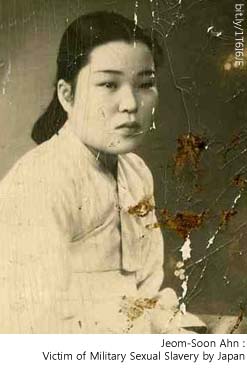

I had no idea where I was, and I became incredibly nauseous...
They (the Japanese soldiers) treated us like we were animals, not human beings. From the very first day, they wouldn’t leave me alone. As soon as I got there, they threw around all kinds of curses at me and were doing horrible, unspeakable things.
As soon as the Japanese soldiers finished their breakfast, they would begin to descend upon us. There was no night and day for us. Saturday and Sunday were resting days, so the weekends were especially worse. I think I had to deal with about ten soldiers per day on the weekdays but more than that on the weekends.
The only thing was that if you didn’t do as they demanded, they would hit you with their fists. Below, I was torn, turned inside out, bleeding...Oh, just thinking about it…
Because of those bastards I was robbed of the springtime of my life. To this day I was unable to marry; I caught anything you could call a disease; I am growing old without a family of my own.”
-Testimony of Jeom-soon Ahn from The Korean Council of the Women Drafted for Military Sexual Slavery by Japan

Why couldn’t the two governments make an agreement for such a long time? Also, how did this agreement and compensation arrive so quickly at this time, unlike in the past? These two ironic questions are the start of the controversy.
The brief history of comfort women between South Korea and Japan may help us to find an answer to the former.
The Japanese Military Sexual Slavery: Comfort Women
According to the book Fifty Years of Ties Between Korea and Japan: Footprints of Conflict and Cooperation, comfort women were first revealed to the public through interviews and testimony on behalf of the victims in 1991. They were forced into sexual servitude for the Japanese military during World War II. At first, the Japanese government insisted that making the women work as sex slaves for the military was against their will. They also argued that it happened only through private enterprise and that the Japanese government had nothing to do with it. The Korean government, however, rebutted this statement with evidence that the Japanese government was not only involved in the process but heavily coerced the women into taking part. This was the start of a controversy between two countries that lasted almost twenty years.
The tension and fierce debate between the two countries, however, eventually calmed down. In 1993, Kono Yohei, the Japanese Chief Cabinet Secretary, acknowledged for the first time in a public statement that the Japanese military was involved in the management of comfort women and had abducted Korean women from their homes to work as sex slaves. Kono tried to fix the government’s previous wrongdoings with a sincere apology which seemed to reduce the tension between two countries.
Following this statement, in 1995, the Asia Women’s Fund made reparations to Korean comfort women. It was a private fund run by several Japanese citizens, with the intention of compensating comfort women in Korea. However, since it was not official money from the Japanese government, most of the victims refused this money and Asia Women’s Fund was shut down in 2007.
Instead of requiring a huge reimbursement to South Korea, the Korean government and the victims requested a factual investigation of comfort women and pressured the Japanese government to address all the criticism it was receiving by the international community. Abe Shinzo, the current prime minister of Japan, however, does not seem to fully want to accept the responsibility of the country’s crimes.
This is the definition of Comfort Women defined by Wikipedia, which is first thing people all around the world can see after Goggling the phrase. On the other hand, Abe has both ignored the definition of the word and denied the statement of Kono. In a 2014 interview with Time magazine, Abe insisted that, “there was no information that shows people were forcibly recruited”. Even after the recent agreement in 2015, Abe argued on January 16th in 2016, that still there is no exact evidence that showed enslavement was forced.
Japan has struggled to deny its coercion and repeatedly insisted that all comfort women’s THINGS were settled in 1965 with the treaty “Basic Relations between Japan and Korea.” Then, how did the 2015 agreement came about? Furthermore, how could both countries could reach such an agreement so hastily at this time?
Of course, there must be other complicated situations that made the both countries urgent to create an agreement, but the most powerful pressure was from the United States of America (USA). According to an interview of Pressian, the Korean political news website, with Su-hun Lee on January 21st, 2016, a professor of Kyungnam University, the USA was a key factor in making the agreement move quickly. Lee said, “The reason that the USA tried to resolve the comfort women agreement now was to reinforce national security cooperation among Korea, USA, and Japan. It was also done to help forge a united front against China and keep that country in check.” During a crisis which has seen both an expansion of Chinese influence in Northeast Asia and a nuclear provocation from North Korea, creating a bond between the three countries was a vital security issue to the USA. This shows that this agreement was not just about apologizing to the victims and a self-reflection of the previous actions. Rather, it was a strategic ploy mostly done for the security interests of the USA, Japan, and even South Korea. These political situations help to explain why the USA intervened in the pending comfort women issue.
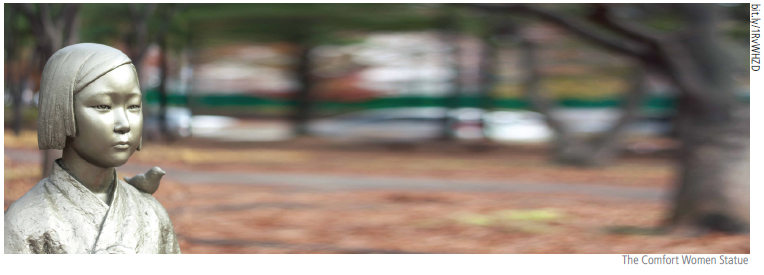
According to a Korea Gallup poll taken from January 5th to 7th this year, 54 percent of respondents had a negative opinion about the comfort women agreement and 26 percent of respondents showed a positive attitude towards it. Even if the trend seems to lean towards disagreement, there are still some positive views on this settlement.
Quoting a conversation between Ki-moon Ban, current Secretary-General of the United Nations, and president Park, Ban applauded the agreement, saying “congratulations” and that “this settlement was an appropriate decision with a clear vision.” When this welcoming statement was announced, Ban received enormous criticism from the public. However, his view has recently been gaining support among those who choose to look at the pros of the agreement. Furthermore, this kind of positive opinion can be found in other countries. In an article from the Huffington post by Jane Harman on January 6th, 2016, the president and CEO of Wilson Center, Jarman mentioned “The country's impressive president, Park Geun-hye, deserves credit for handling a sensitive issue with care.”
However, as mentioned above, over half of the respondents thought the recent agreement did not reflect the victims’ opinions and that the apology was inappropriate and half-hearted. In general, public opinion does not seem amicable to the settlement.
Sun-joo Park (Dept.of Business Administration, ’15) said, “The paperwork, which did not especially reflect the victims’ opinions, could not solve this historical problem. Self-acknowledgment, a sincere apology and forgiveness are the best way to terminate the controversies”
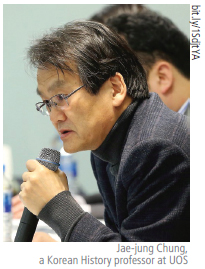
The lack of a sincere apology, a dogmatic settlement not involving the actual victims, and a misleading report about the removal of the comfort women statue can all be reasons why public sentiment is trending strongly against the government’s “final and irreversible” agreement. Even though the South Korean government has made attempts to visit the victims and seek cooperation, these actions have were viewed as disingenuous and have caused even more resistance from the opposition side of the settlement. Therefore, after the agreement, the conflict between the ruling party and the opposition party became harsher. As for requiring a final renegotiation about comfort women, the opposition party is protesting that this humiliating agreement should be nullified.
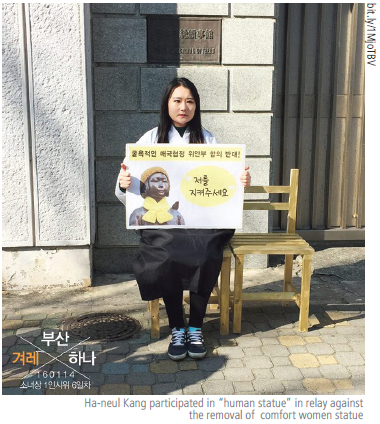
Right after the release of the agreement, the presses in not just one or two countries but around the world were busy featuring the settlement. Among them, the most dismaying title of the articles was “the removal of comfort women statue.” This rumor brought severe sensation among Koreans, since the statue is a memento mori of innocent victims. This total rumor first came out from a newspaper in Japan, saying that the Japanese government is expecting the Korean government to get rid of the comfort women statue which has embarrassed Japan for such a long time. They also mentioned that this removal was one part of the settlement. Even the South Korean government explained that the removal of the comfort women statue had never been planned, and the news from the Japanese press was a rumor, protestors gathered in front of the Embassy of Japan to show their discontents.
The UOS Times interviewed Ha-neul Kang, a student at Pusan National University who participated in the protest opposing to the removal of the comfort women statue. Busan, where Kang joined the protest, has no comfort women statue. Instead, the protestors created a “human statue” in relay to protect the comfort women statue all around the world. Asked about the reasons behind her motivation to participate, Kang answered, “Actually I was a substitute that day. However as a Korean and a woman, I could not help sympathizing and have always thought that I should do something for the victims.” Even though the weather was cold and there are not many eyes watching, she said, there are people who applauded in their cars and honked for their support.
She criticized the agreement for using the victims as “tools of political leverage” and pointed out that there was no explanation to the victims before the settlement was reached. She said. “Given that there lacked any sincere apology or regret, this agreement shows the ineptitude of the South Korean government.” Additionally, despite it being called an “agreement” there was no actual “agreement” from the victims.

Almost 200,000 women were forced into sex slavery during wartime. Most of them were Koreans. However, there were also victims from China, Philippines, Indonesia, and Taiwan. After South Korea and Japan reached the agreement, the governors and spokesmen of those countries immediately requested a statement for the victims in their countries. The Taiwanese government said that the same apology and compensation should be given for their victims. On the other hand, during an interview with the BBC on December 26th, 2015, China’s Foreign Ministry spokesman, Lu Kang, pressured and warned Japan by saying, “we will wait and see if its words and actions are consistent from start to finish.”
Beyond the public statements made by their governments, victims and supporters of comfort women from these various countries held demonstrations against Japan. On January 27th, when Japan emperor Akihito visited the Philippines, victims and supporters requested settlements for their suffering starting from World War II to the present day. Still, there are many more victims remaining who are requesting their right to compensation. This is similar to South Korean victims, who are refusing to just pass this tragedy onto next generation. Considering this aftermath, it would be a huge mistake for Japan to thinks that this recent agreement with South Korea will loosen the blame. It seems impossible, for quite a while at least, that Japan can get be excised of all criticism even after the 2015 agreement.
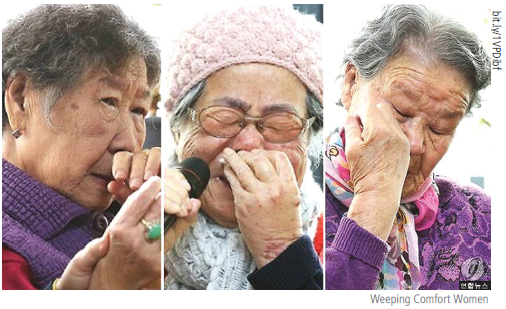
There was strong criticism posted on twitter by one of the civil campaigners about the monetary compensation that South Korea got from Japan. According to him, the money that South Korea donated to Japan in 2011 when the tsunami struck was 15.5 billion won. However, the compensation that South Korea will get from Japan for the apology is only 9.6 billon won which is less than two thirds of the former. Even though what the victims want more than monetary compensation is a sincere apology, some view 9.6 billon as ridiculously lower than what they truly deserved. There is no consensus about how much money the victims should receive. The money, however, should be an amount that can be accepted by every nation.
---------------------------------------------
Now, there is finally an agreement between South Korea and Japan, and the victims will receive reparations. Then, is it done? Is this controversy over from now on? As mentioned above, this agreement is called “final and irreversible.” However, there should be a modification of the word “final.” According to Pascal Boniface’s interview in the Dong-A Ilbo, “Agreement is just a first step towards reconciliation. This one agreement should not cover the past and all wrongdoings. This historical moment should be covered in all textbooks in both countries for the next generation.” Also Wada Haruki, an emeritus professor at the University of Tokyo, stated that this agreement should not be the finish line, and that the Japanese government should take additional actions that convey the real meaning and intention of the settlement. As both of them said, this agreement does not mean that the comfort women problem is over. Rather, this is another way to restart reconciliation and the addressing of this controversy. Until victims all around the world receive an apology which they find fully acceptable and completely satisfying, and until we continue to let each new generation know what happened in the past, there will be numerous debates and controversies.
Young-eun Choi
emilyc95@uos.ac.kr

